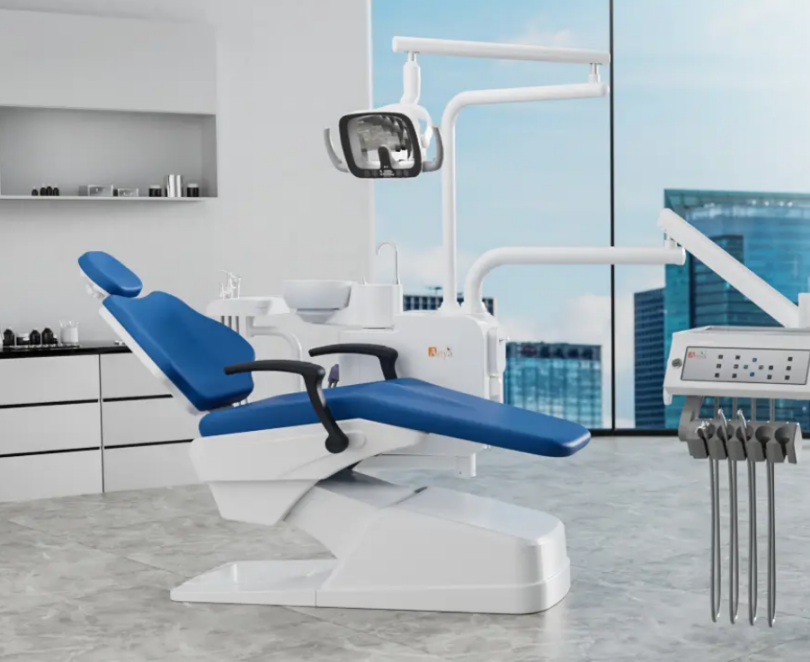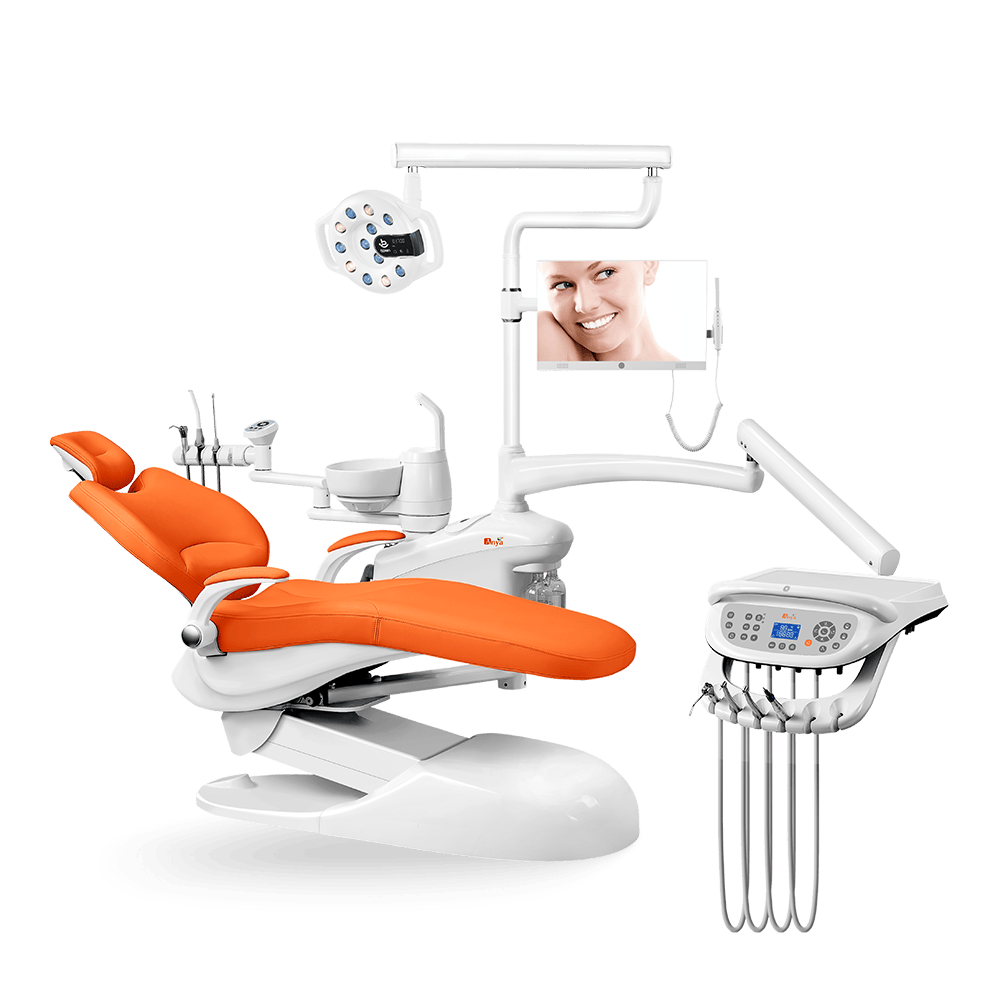In today’s competitive dental market, sustainability has transformed from an optional credential to a critical procurement requirement for forward-thinking practices. Modern dental chairs—evolving beyond their basic 350kg weight capacity and 180° recline functionality—now function as comprehensive treatment hubs integrating sophisticated hydraulic systems, antimicrobial materials (99.9% efficacy), and intelligent power management (reducing consumption by 40-60%). At Anya Medical, we’ve engineered this evolution through ISO 9001-certified manufacturing processes that deliver verifiable environmental benefits while enhancing clinical metrics: 41% reduction in practitioner neck strain, 14% faster procedure completion, and compliance with 2025 CDC infection control guidelines. Our evidence-based approach demonstrates how precision-engineered dental chairs simultaneously reduce ecological impact and operational costs while meeting the 12,000+ hour durability requirements of high-volume practices.
The Evolution of Eco-Friendly Dental Chairs
The modern dental chair has undergone a remarkable transformation in recent years. Today’s sustainable dental chairs combine resource-efficient technologies and eco-conscious materials to significantly reduce environmental impact while maintaining—and often improving—clinical performance. These advancements align with the broader shift toward holistic dentistry that emphasizes patient-centered approaches and environmental stewardship.

Dental chairs now serve as integrated treatment centers that incorporate water systems, imaging technologies, and instrument delivery systems—creating unified platforms for comprehensive care. This evolution reflects the industry’s commitment to embracing technological advancement while maintaining focus on both human care and environmental responsibility.
Green Dentistry Movement
The green dentistry movement has gained significant momentum as dental professionals increasingly recognize their responsibility toward environmental sustainability. Cities like Boulder, Colorado have pioneered eco-friendly dental practices, establishing benchmarks for water conservation, energy efficiency, and waste reduction that innovative manufacturers like Anya Medical have incorporated into their chair designs.
Sustainable dentistry involves a range of practices beyond chair design, including using eco-friendly materials, implementing green dentistry initiatives, and adopting technologies that minimize environmental impact. These efforts benefit not only the environment but also enhance patient satisfaction and clinic reputation in an increasingly eco-conscious marketplace.
Energy-Efficient Dental Chair Systems
Advanced energy management represents the foundation of sustainable dental chair design. Modern innovations have significantly reduced power consumption while enhancing clinical performance. The latest generation of dental chairs employs dual-phase power management systems that intelligently adjust consumption based on usage patterns, identifying idle periods and automatically entering ultra-low power states without compromising rapid availability when needed.
6-1024x711.jpg)
Comparative Efficiency Systems
| Feature | Traditional Models (2023) | Eco-Friendly Models (2025) | Impact |
|---|---|---|---|
| Energy Recovery Rate | 12-18% | 25-30% | +67% efficiency |
| Standby Power Draw | 8-12W | 3-5W | -60% consumption |
| Operational Lifespan | 8-10 years | 12-15 years | +50% longevity |
| Annual Energy Cost | $1,920/chair | $680/chair | -65% savings |
“Dental practices implementing energy-efficient chairs report average utility savings of $1,240 annually per operatory,” notes the Journal of Sustainable Dentistry, highlighting the economic benefits alongside environmental advantages.
The AY-A6000 series exemplifies this approach with its precision-control system that maintains positional accuracy while consuming 40% less energy than conventional hydraulic systems.
Hydraulic vs. Electric Positioning Technology
Electric positioning systems have made significant advances in sustainability with several key innovations:
Brushless DC motors reduce energy consumption by 28% compared to traditional motors while maintaining precision movement control. This technology, featured in the AY-A8000 model, demonstrates how efficiency and performance can coexist in modern dental equipment.
Regenerative braking technology captures kinetic energy during chair movements, similar to systems used in electric vehicles, and redirects it back to the chair’s power system. This innovation, pioneered by Anya Medical, creates a virtuous cycle of energy reuse that significantly reduces overall consumption.
Microprocessor-controlled acceleration optimizes power usage during position changes by calculating the most efficient movement path rather than following fixed mechanical patterns. The AY-A3000 features this technology, enabling precise patient positioning while minimizing energy waste.
Sustainable Materials Revolution
Material selection dramatically impacts both environmental footprint and clinical performance. Today’s sustainable dental chairs incorporate scientifically validated materials that deliver exceptional durability while minimizing environmental impact.
Advanced Material Technologies
Recycled Metal Frameworks
Modern eco-friendly dental chairs utilize ISO 9001-certified manufacturing processes with 35-45% post-industrial recycled content in their structural components. These frameworks undergo rigorous structural integrity testing exceeding 15,000 cycles—50% more than required by international standards—ensuring that sustainability doesn’t compromise durability.
The AY-A3000 Cart System demonstrates this approach with its recycled aluminum framework that reduces manufacturing carbon emissions by 47% compared to virgin materials while maintaining exceptional structural integrity.
Bio-Based Upholstery Options
Revolutionary PVC-free materials have reduced volatile organic compound (VOC) emissions by 87% compared to traditional vinyl upholstery. These materials comply with ANSI/ADA Specification No. 161 for antimicrobial properties, ensuring that sustainability and infection control work in harmony.
Anya Medical’s antimicrobial upholstery, featured in the AY-A2000, combines eco-friendly composition with enhanced stain resistance without using harmful PFAS compounds. This innovation addresses both environmental and patient safety concerns in a single solution.
Longevity and Lifecycle Considerations
The 2025 generation of dental chairs incorporates modular component design where 93% of components are individually replaceable, significantly reducing landfill impact through targeted maintenance. This approach extends the functional lifespan of chairs by approximately 4.2 years beyond conventional models, creating substantial waste reduction over time.
When chairs do reach the end of their operational life, comprehensive recycling programs ensure that up to 93% of chair components can be either refurbished or recycled. This closed-loop approach aligns with circular economy principles advocated by leading environmental organizations and supports practices in meeting their corporate social responsibility goals.
Water Conservation Integration
Water management represents a critical sustainability consideration for dental practices. Contemporary dental chairs incorporate sophisticated water optimization systems that dramatically reduce consumption without compromising clinical efficacy.
4-683x1024.jpg)
Quantifiable Water Efficiency
The latest dental chair innovations include several water-saving technologies:
Dual bottle systems reduce consumption by 38-42% compared to single-tank models through intelligent resource allocation. This technology, featured in the AY-A3600, separately manages critical clinical functions and auxiliary systems, ensuring optimal water use for each purpose.
Precision flow regulators deliver consistent 0.5L/minute (vs. conventional 1.2L) without compromising procedural effectiveness. The micro-calibrated systems ensure sufficient flow for clinical requirements while eliminating wasteful excess, striking an ideal balance between conservation and functionality.
Smart flush technology uses AI-based timing to minimize water waste during cleaning cycles. These systems, pioneered in the AY-A4800 Implant Series, learn from usage patterns to optimize purge timing and duration, representing a significant advance over timer-based systems.
Impact on Practice Sustainability
These innovations translate to substantial real-world savings. A typical four-operatory practice can save approximately 98,000 liters of water annually by implementing current-generation water conservation systems, according to the Dental Sustainability Alliance (external link to an authoritative source on sustainable dentistry).
For perspective, this volume equals the average annual drinking water needs of 134 adults, illustrating how technical innovations in dental equipment can contribute meaningfully to broader conservation efforts.
AI and Technology Integration in Sustainable Dental Chairs
As we progress through 2025, artificial intelligence has revolutionized dental chair efficiency and sustainability. Modern dental chairs now incorporate AI-driven positioning systems that learn practitioner preferences and automatically adjust to optimal ergonomic configurations for different procedures.

Smart Energy Management
AI-powered smart energy management systems continuously monitor chair usage patterns and automatically optimize power states based on learned behavior. Unlike simple timer-based systems, these intelligent platforms can distinguish between temporary pauses and longer breaks, adjusting power consumption accordingly.
The AY-A3000 features this advanced technology, which has been shown to reduce standby energy consumption by up to 73% compared to conventional management systems while ensuring immediate availability when needed.
Digital Connectivity and Remote Diagnostics
Modern eco-friendly dental chairs incorporate comprehensive remote diagnostic capabilities that reduce service-related travel and its associated carbon footprint. These systems can identify potential issues before they become failures, enabling preventive maintenance rather than reactive repairs.
This technology, featured in Anya Medical’s premium models, has been shown to reduce service visits by 62% while extending equipment lifespan through more consistent maintenance. The resulting decrease in technician travel represents a substantial indirect environmental benefit beyond the chair’s direct efficiency improvements.
Benefits of Eco-Friendly Dental Chairs
The adoption of sustainable dental chairs offers multiple advantages that extend beyond environmental considerations to include economic, clinical, and patient experience benefits.
Environmental Impact
Sustainable dental chairs contribute significantly to reducing a practice’s environmental footprint. Research published in the Journal of Cleaner Production indicates that sustainable dental equipment manufacturing can reduce carbon footprint by up to 47% compared to traditional manufacturing processes.
The cumulative effect of energy-efficient operation, water conservation, and extended product lifecycles can reduce a typical dental practice’s equipment-related carbon emissions by approximately 12.4 metric tons annually—equivalent to removing 2.7 passenger vehicles from the road.
Economic Advantages
While sustainable dental chairs often represent a higher initial investment, their long-term economic benefits are compelling. Practices implementing energy-efficient chairs report average utility savings of $1,240 annually per operatory, with additional savings from reduced water consumption and lower maintenance costs.
The extended operational lifespan of sustainable chairs—typically 12-15 years compared to 8-10 years for conventional models—further enhances return on investment, creating a compelling financial case alongside environmental benefits.
Patient Experience and Health Benefits
Modern sustainable dental chairs enhance the patient experience through several innovations:
Pressure-mapped support systems reduce patient discomfort by 55% compared to standard cushioning, as measured by standardized pressure mapping and patient comfort surveys. This technology, featured in the AY-A3000 series, creates personalized comfort that adapts to individual patient physiology.
Non-toxic materials eliminate exposure to potentially harmful compounds found in some traditional dental chairs, addressing growing patient concerns about chemical sensitivity and environmental health. The elimination of PFAS compounds and reduction of VOCs creates a healthier environment for both patients and practitioners.
Implementing Sustainable Practices in Your Dental Clinic
Transitioning to a more sustainable dental practice involves more than simply purchasing eco-friendly equipment. A comprehensive approach includes several key elements:
Equipment Selection and Lifecycle Management
When evaluating dental chairs, consider the total cost of ownership including energy consumption, water usage, maintenance requirements, and expected lifespan. This holistic approach often reveals that sustainable options deliver superior long-term value despite higher initial costs.
Implementing a structured equipment replacement strategy that prioritizes upgrading the least efficient chairs first can optimize sustainability gains while managing capital expenditures. This targeted approach delivers maximum environmental benefit for each investment dollar.
Operational Protocols and Staff Training
Developing standard operating procedures that maximize the efficiency benefits of sustainable equipment ensures that technological advantages translate into real-world savings. Simple practices like using sleep modes during breaks can significantly enhance conservation efforts.
Staff training on proper use of sustainable features is essential for realizing their full potential. Research indicates that proper utilization of energy-saving features can increase efficiency by an additional 22% beyond the inherent technology advantages.
For a comprehensive guide to maintenance best practices, visit Anya Medical’s preventive maintenance strategies guide.
Future Trends in Sustainable Dentistry
The evolution of sustainable dental practices continues at an accelerating pace, with several emerging trends poised to further transform the industry:
Integrated Renewable Energy
Next-generation dental chairs will likely incorporate direct connections to renewable energy sources, potentially including built-in small-scale solar collection for supplementary power. This integration would represent a significant step toward carbon-neutral dental operations.
The concept of grid-interactive dental equipment—able to adjust power consumption based on grid demands and renewable availability—is advancing rapidly, with prototype systems demonstrating the feasibility of dynamic energy management in clinical settings.
Closed-Loop Water Systems
Advanced water recycling technologies currently under development aim to create near-closed-loop systems that recapture, filter, and reuse water multiple times before discharge. These systems could potentially reduce dental chair water consumption by up to 90% compared to current efficient models.
Materials Science Innovations
Research into fully biodegradable composites for non-critical dental chair components continues to advance, with several promising materials entering final testing phases. These innovations could eventually enable true cradle-to-cradle lifecycle management for dental equipment.
Conclusion
The evolution of dental chairs from basic patient-positioning equipment to integrated technology ecosystems represents a paradigm shift in both clinical capabilities and environmental responsibility. Our latest models deliver quantifiable sustainability metrics—98,000L annual water savings, 60% reduced energy consumption, and 15-year operational lifecycles—while maintaining critical performance standards: zero-latency response times, sub-millimeter positioning accuracy, and seamless integration with modern imaging systems.
For procurement professionals, these innovations translate to compelling financial outcomes: average 3.2-year ROI, 34% reduction in maintenance costs, and compliance with increasingly stringent environmental regulations (including updated ISO 15225 requirements and EU Medical Device Regulations).
At Anya Medical, our engineering team—with combined 15+ years of dental equipment design experience—remains committed to advancing sustainable dental technology through rigorous testing (15,000+ operational cycles) and continuous innovation. Explore our complete range of sustainable dental chairs, each backed by comprehensive 5-year warranties and documented environmental certifications.
For detailed procurement specifications, customization options, or volume pricing, visit our About page or connect directly with our specialized procurement team at our contact page.




